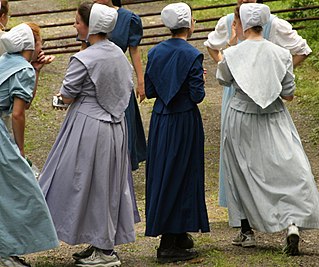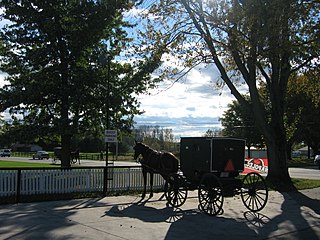Old Order Brethren is Old Order groups of the Schwarzenau Brethren. [1] There are five of these Old Order groups:
The Old Order Movement is a religious movement to preserve the old ways of Anabaptist religion and lifestyle. Historically, it emerged in the second half of the 19th century among the Amish, Mennonites of South German and Swiss ancestry as well as the Schwarzenau Brethren in the United States and Canada. The movement led to several Old Order divisions from mainstream Anabaptist groups between 1845 and 1901. All Old Order groups that emerged after 1901 divided from established Old Order groups or were formed by people coming from different Old Order groups. The highly conservative Old Colony Mennonites and the Hutterites were not directly connected to this movement.

The Schwarzenau Brethren, the German Baptist Brethren, Dunkers, Dunkards, Tunkers, or simply the German Baptists, are an Anabaptist group that originally dissented from several Lutheran and Reformed churches that were officially established in some German-speaking states in western and southwestern parts of the Holy Roman Empire as a result of the Radical Pietist ferment of the late 17th and early 18th centuries.
- Old German Baptist Brethren, emerged 1881, with about 4,000 members the largest of these Old Order groups and more liberal than the following three groups.
- Old Brethren, emerged 1913, with about 250 members in 2000, a bit more conservative than the Old German Baptist Brethren but in many aspects similar to them.
- Old Order German Baptist Brethren, emerged 1921, with about 125 members in 2000, a horse and buggy group that uses tractors for field work.
- Old Brethren German Baptists, emerged 1939, with about 130 members in 2015, a horse and buggy group that also uses horses for field work, the most conservative group.
- Old German Baptist Brethren, New Conference, emerged 2009, with about 2,000 members, a more liberal split from the Old German Baptist Brethren.

The Old German Baptist Brethren (OGBB) is a conservative Plain church that emerged from a division among the German Baptist Brethren in 1881 being part of the Old Order Movement. Like the church it emerged from, it has roots both in Anabaptism and in Pietism. It rejects baptism of infants as a biblically valid form of baptism. It is one of several Schwarzenau Brethren groups that trace their roots to 1708, when eight believers founded a new church in Schwarzenau, Germany. The Old German Baptist Brethren church has about 4,000 baptized members.

The Old Brethren are a group of Schwarzenau Brethren who split from the Old German Baptist Brethren in Carroll County, Indiana, in 1913, and in Stanislaus County, California, in 1915. They are a believer's church made up of those who choose to be baptized in their teen or adult years.

The Old Order German Baptist Brethren, also called Petitioners, are a small group of very conservative Schwarzenau Brethren.





